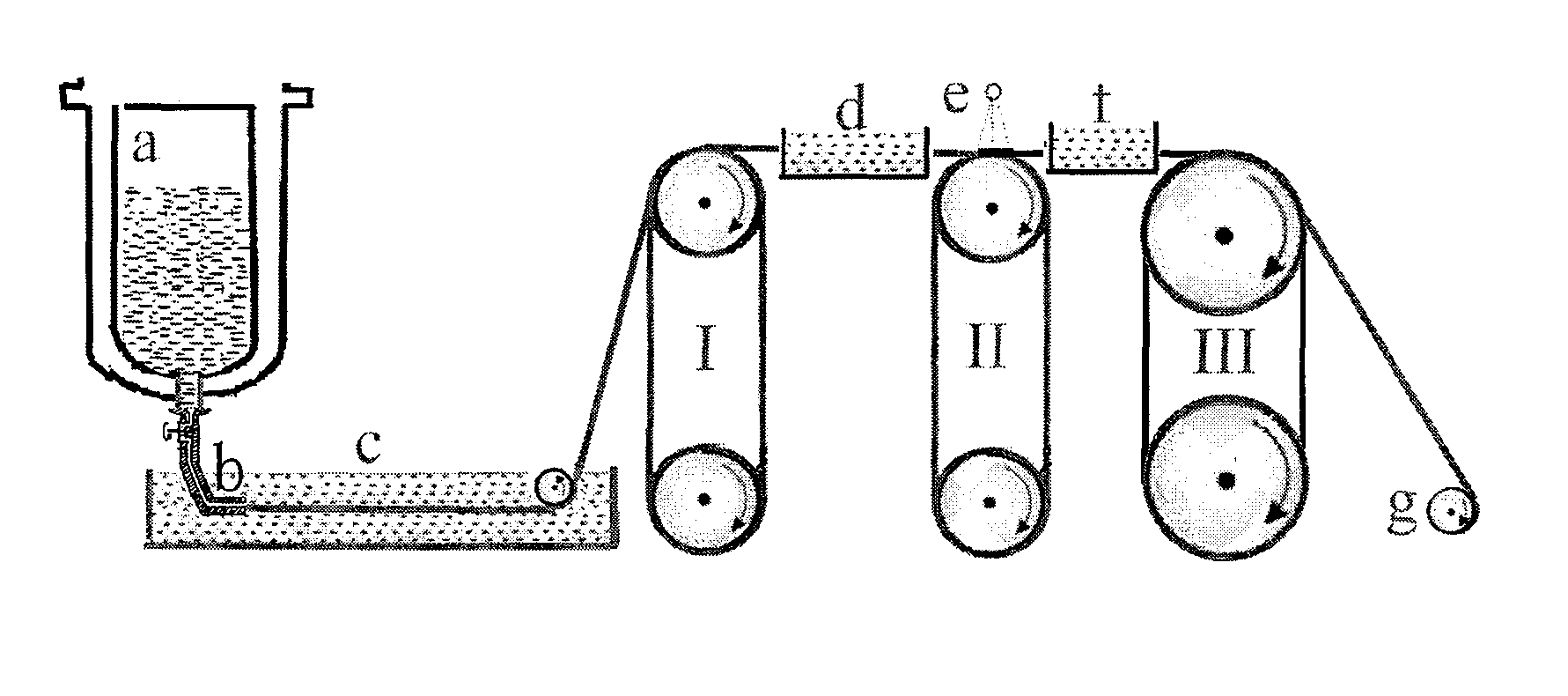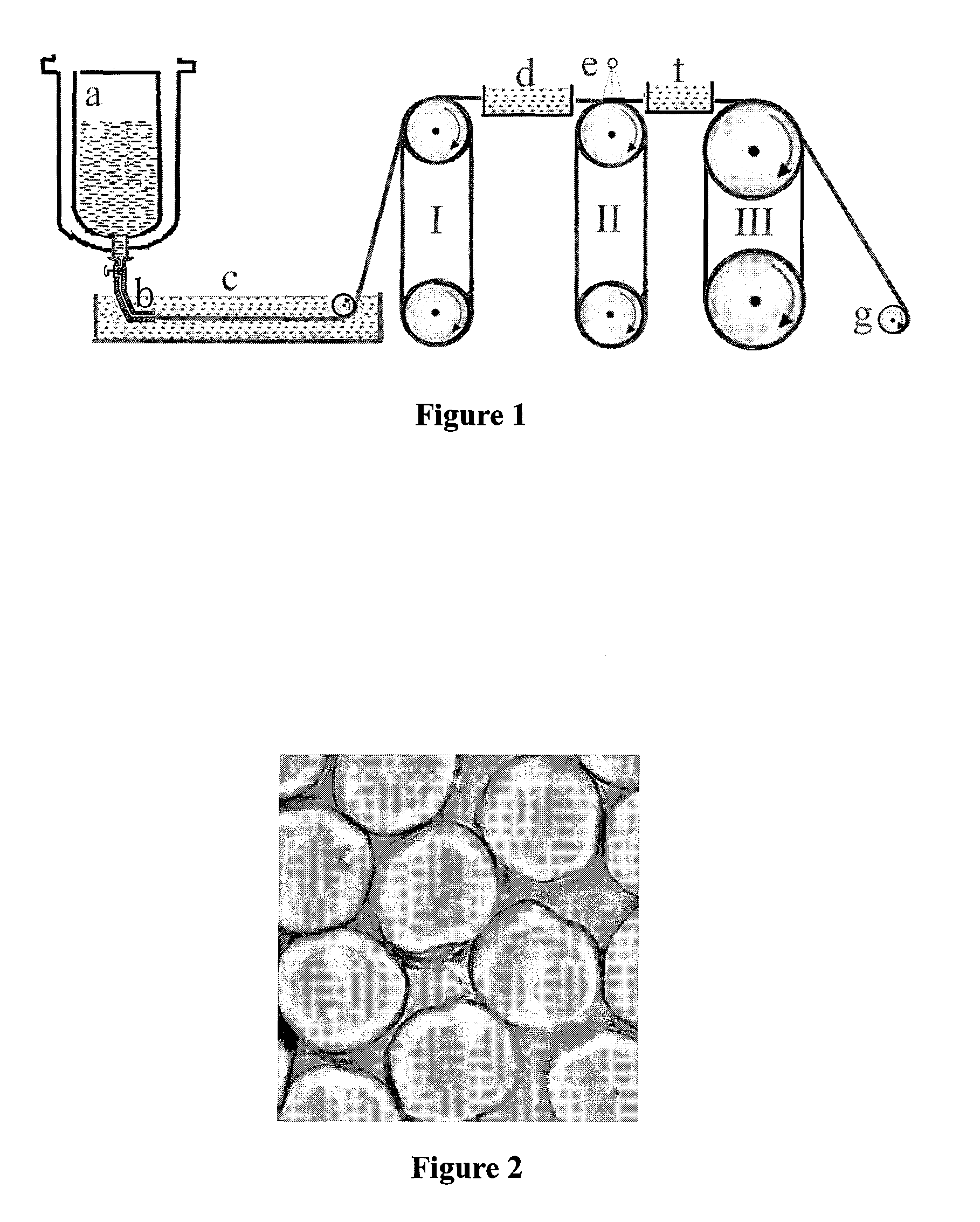Use of aqueous NaOH/thiourea solution in pilot-scale production of cellulose products
a technology of cellulose products and aqueous sodium hydroxide, which is applied in the direction of organic non-macromolecular adhesives, textiles and paper, coatings, etc., can solve the problems of high cost and difficulty in recovering solution, the cuprammonium process for producing cuprammonium rayon also has drawbacks of environmental pollution, and the cellulose is currently far from being sufficiently utilized in the chemical industry. , to achieve the effect of low cost, high safety and high added valu
- Summary
- Abstract
- Description
- Claims
- Application Information
AI Technical Summary
Benefits of technology
Problems solved by technology
Method used
Image
Examples
example 1
[0038]3 kg of a mixed aqueous solution of 9.5 wt % NaOH / 4.3 wt % thiourea (analytically pure) was pre-cooled to −4.8° C., then 152 g of dry cotton linter cellulose pulp (having a polymerization degree of 620) was added immediately, while stirring under 720 rpm at room temperature for 15 minutes to dissolve the cellulose completely. A transparent cellulose solution was obtained by deaerating under vacuum at 5° C. for 12 hours. The obtained cellulose solution was pressed to pass through a spinneret and entered into a first coagulation bath for solidification, wherein the bath was a mixed aqueous solution of 15 wt % H2SO4 / 10 wt % Na2SO4 and the bath temperature was 10° C. Subsequently, the cellulose filaments entered into a second coagulation bath for regeneration, wherein the bath was an aqueous solution of 5 wt % H2SO4 and the bath temperature was 10° C. The stretched and regenerated cellulose filaments were washed with water and entered into a plasticizer tank for oiling, dried by a...
example 2
[0039]3 kg of a mixed aqueous solution of 9.5 wt % NaOH / 4.3 wt % thiourea (analytically pure) was pre-cooled to −4.8° C., and then 178 g of dry cotton linter cellulose pulp (having a polymerization degree of 440) was added immediately, while stirring under 720 rpm at room temperature for 15 minutes to dissolve the cellulose completely. A transparent cellulose solution was obtained by deaerating under vacuum at 5° C. for 5 hours. The obtained cellulose solution was pressed to pass through a spinneret and entered into a first coagulation bath for solidification, wherein the bath was a mixed aqueous solution of 9.0 wt % H2SO4 / 11.2 wt % Na2SO4 and the bath temperature was 15° C. Subsequently, the cellulose filaments entered into a second coagulation bath for regeneration, wherein the bath was an aqueous solution of 5 wt % H2SO4 and the bath temperature was 15° C. The stretched and regenerated cellulose filaments were washed with water and entered into a plasticizer tank for oiling, drie...
example 3
[0040]3 kg of a mixed aqueous solution of 9.5 wt % NaOH / 4.3 wt % thiourea (industrially pure) was pre-cooled to −4.6° C., and then 178 g of dry cotton linter cellulose pulp (having a polymerization degree of 440) was added immediately, while stirring under 720 rpm at room temperature for 15 minutes to dissolve the cellulose completely. A transparent cellulose solution was obtained by deaerating under vacuum at 5° C. for 5 hours. The obtained cellulose solution was pressed to pass through a spinneret and entered into a first coagulation bath for solidification, wherein the bath was a mixed aqueous solution of 12.2 wt % H2SO4 / 13.6 wt % Na2SO4 and the bath temperature was 12.2° C. Subsequently, the cellulose filaments entered into a second coagulation bath for regeneration, wherein the bath was an aqueous solution of 5 wt % H2SO4 and the bath temperature was 13.6° C. The stretched and regenerated cellulose filaments were washed with water and entered into a plasticizer tank for oiling,...
PUM
| Property | Measurement | Unit |
|---|---|---|
| temperature | aaaaa | aaaaa |
| temperature | aaaaa | aaaaa |
| temperature | aaaaa | aaaaa |
Abstract
Description
Claims
Application Information
 Login to View More
Login to View More - R&D
- Intellectual Property
- Life Sciences
- Materials
- Tech Scout
- Unparalleled Data Quality
- Higher Quality Content
- 60% Fewer Hallucinations
Browse by: Latest US Patents, China's latest patents, Technical Efficacy Thesaurus, Application Domain, Technology Topic, Popular Technical Reports.
© 2025 PatSnap. All rights reserved.Legal|Privacy policy|Modern Slavery Act Transparency Statement|Sitemap|About US| Contact US: help@patsnap.com



